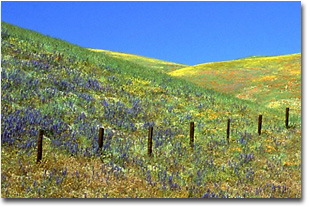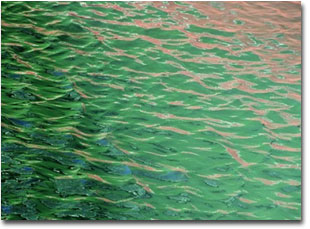|
|

Artist's Perspective... The Role of Lines
Text and Photography Copyright Dale Proctor
Now here it is 2002 with all the equipment being produced to take the most incredible pictures and, photographers are still fumbling with that darned equipment. Let me tell you that all of this newfangled gear is not going to get you incredible pictures - you are. As long as the photographic gear you’re using functions properly, you can get great pictures. Sure, for specialized subjects you must have certain lenses but to learn photography well you only need good working equipment. The part of the photography process that needs the most attention is understanding how you see things, and getting that on the film successfully so others can share the feeling of what you saw. Notice I said feel which is an emotional response. Now we’re getting somewhere. So now we come to part of photography which I knew something about from the beginning - the artistic side - and that is what this column is about. See, I now make pictures - I don’t take them. I make them the way I want those pictures to be because I control the picture making process and you should too. I am going to explain thoughts I had while making the images displayed in this column. I will also give insight into the areas where you can make a big difference in your work. First, let's take a look at the role lines play in Art and Photography Lines are incorporated within most all pictures. Whether subtle or dramatic, the use of lines is important for a photographer to understand when arranging their composition. Lines are used to move the viewers eyes into and around the picture. Put a line in the wrong place and you risk blocking the viewer from feeling your message.
The horizon line is a good example of a line often used to show perspective in a landscape photographers composition. If the horizon line has been placed high, at the top of the picture, emphasis is usually being placed on the foreground. When the horizon line is low, towards the bottom, the sky is said to be more prominent. Generally, the horizon line should be placed to divide the picture into unequal parts. The photographer controls this line placement with composition using lines to lead the viewer’s eye towards the center of interest. A row of tree tops may angle to the center of interest in your composition. Shadows form lines on the ground which also may be used to lead to the point of interest. Curved lines, like curving lines created by branches on trees, curves in lakes and bays are a good example of how to move the viewers eye towards your point of interest. Curves are found often in nature. Rocks, creeks, hills, flowers, are all proof of this. Don’t forget, clouds have curves and lines too. Crooked lines can be found where the earth has moved (expansion and contraction). Examples of jagged lines are in dried mud left from a hot summer. Cracks in ice, rock and stones, cliffs, tree bark showing growth, and edges of leaves are all part of nature and are abundant. A repeating line is the start of a pattern as in the bark of some trees. This also happens with ripples in water. Clouds, leaves, bird feathers, and shadows all create patterns as well. Notice how a wasps nest is made or the pine cone from a tree is formed. How about the skin of a snake or the coat on a mammal? Look how flowers and bushes have layered lines from the foliage. Take a quick look up in the sky next time you’re outside when there are clouds, and notice the repeating lines created by wind and the turbulent atmosphere. Dew drops, snow flakes, and spider webs all form patterns and are filled with great photo opportunities for the close up macro photographer.
Lines help to create depth in a composition. The angling or tapering seen from converging lines when using a wider focal length lens is a great example of how lines affect your composition with perspective. A feeling of depth draws the viewer into the picture, producing a feeling of involvement, a sense of being there. A word of caution is needed here. When overdone, convergence will ruin an otherwise great image. The photographer must learn to temper use of equipment but never temper the use of creativity. A photographer must pay attention to all of the elements within a scene to make sure they are consistent with the message of the picture and with the photographic techniques being applied. You may notice some of these suggested subjects may require specialized macro photography equipment. This investment may be well worth your investigating. Just remember, lines help the viewers “see” what you are communicating. Editor's Note - Visit Dales web site at www.californiapictures.com to view more of his work. DP - NPN 368 Comments on this article? Send them to the editor. |
|
|
 I remember when I was first interested in photography. Sure I was excited when buying my first camera and rightfully so. Why shouldn’t a person be excited about taking pictures, I mean, just look at all the beautiful subjects we have outside in nature. Of course I knew absolutely nothing about the camera gear I was now the proud owner of, nor did I know anything about photography. I did, however, know something about art. But according to what I had read in photography magazines, photography was not art, so that was not going to help. What I needed was to learn how to operate the camera and the technical things involved with the photographic process. Well, I liken that stuff to driving a car. But many of us get caught up in the technical stuff because that’s where the marketing departments niche their wares. Do we really need to practice how to drive for years on end? No we don’t - as long as we learn right the first time, we can repeat the process over our lifetime without going “remedial.”
I remember when I was first interested in photography. Sure I was excited when buying my first camera and rightfully so. Why shouldn’t a person be excited about taking pictures, I mean, just look at all the beautiful subjects we have outside in nature. Of course I knew absolutely nothing about the camera gear I was now the proud owner of, nor did I know anything about photography. I did, however, know something about art. But according to what I had read in photography magazines, photography was not art, so that was not going to help. What I needed was to learn how to operate the camera and the technical things involved with the photographic process. Well, I liken that stuff to driving a car. But many of us get caught up in the technical stuff because that’s where the marketing departments niche their wares. Do we really need to practice how to drive for years on end? No we don’t - as long as we learn right the first time, we can repeat the process over our lifetime without going “remedial.”  The line can be of any shape or angle. It has been said you don’t see a straight line in nature and I believe that is true. A line may be single like the stem on a flower or repeating like repetitive lines in a range of mountains separated by foggy or hazy ridgelines.
The line can be of any shape or angle. It has been said you don’t see a straight line in nature and I believe that is true. A line may be single like the stem on a flower or repeating like repetitive lines in a range of mountains separated by foggy or hazy ridgelines. Let lines bring the viewers eye into the picture, not block them out.
Let lines bring the viewers eye into the picture, not block them out.